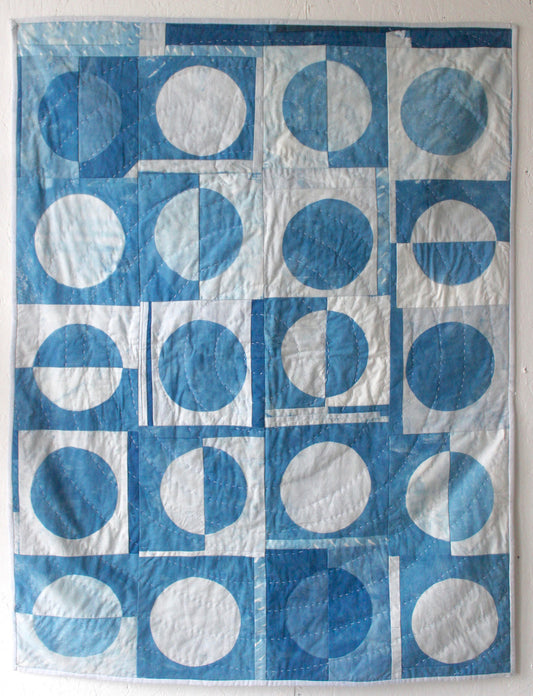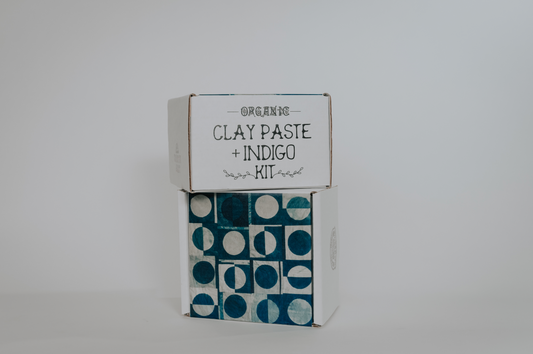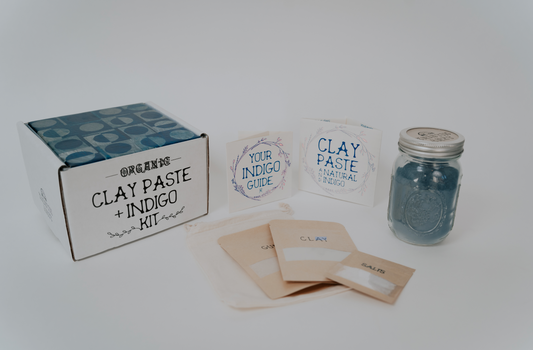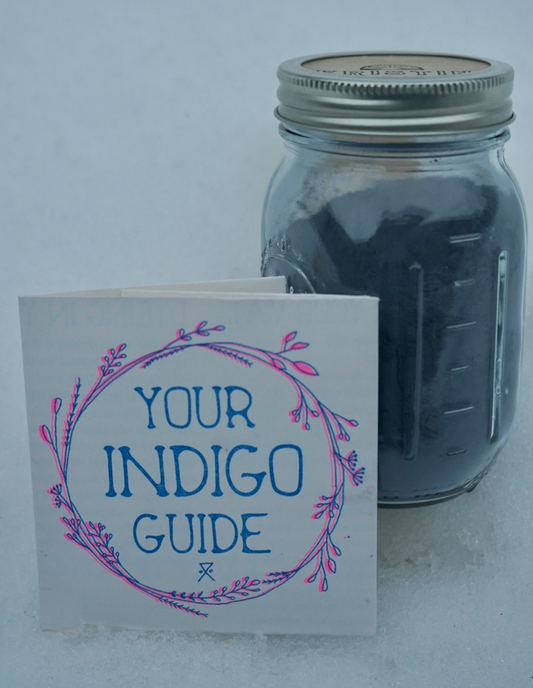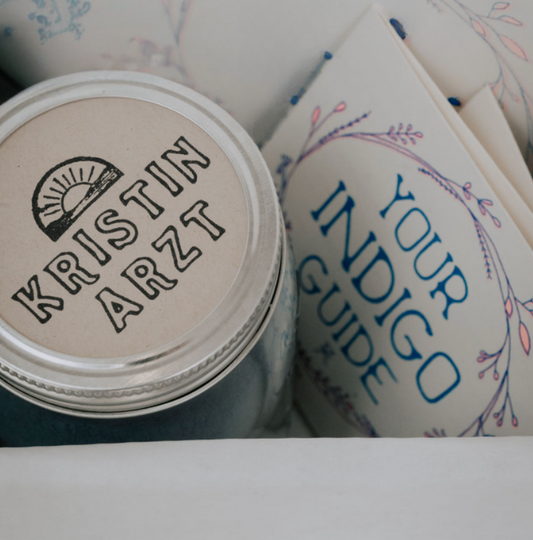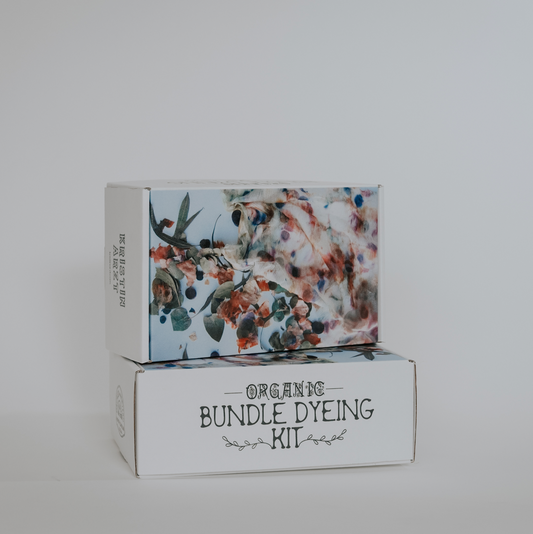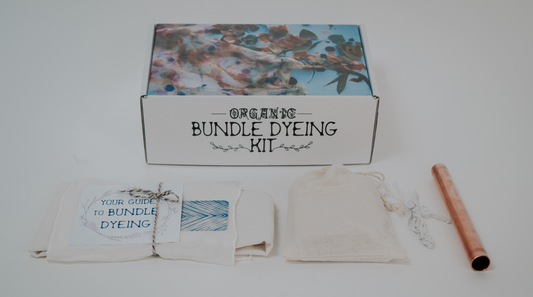In today’s guide, I'll walk you through my tried and true method to creating a rainbow with natural dyes. Who doesn’t love a rainbow? And dare I ask, who doesn’t love plants? Here is how you can dye a full spectrum of colors, from sunny yellows to deep purples, using just three plants—indigo, madder, and weld.

What You’ll Need to Get Started
Before we dive into the dyeing process, let’s talk about the tools and materials you’ll need. To create your natural dye rainbow, you’ll need:
Tools: Tongs, spoons, pots, strainers, measuring containers (like jars or yogurt cups), and 5-gallon buckets.
Equipment: A gram scale, access to water and a stove, and safety gear like a respirator or quality mask and nitrile gloves (especially when working with metal salts).
Pro tip: Keep your dyeing equipment separate from your kitchen tools to avoid contamination.
Fiber Types
Natural dyes work best with natural fibers, which fall into two categories:
Cellulose fibers (plant-based): Cotton, hemp, linen, ramie, and more.
Protein fibers (animal-based): Silk, wool, and leather.

Preparing Your Fibers for a Natural Dye Rainbow
Before you dye, your fibers need to be prepped to ensure maximum bonding of pigment to fiber. Preparing your fibers using metal salts also prevents your fabric from fading quickly in the sun or wash. Here’s how:
1. Scouring
Commercially prepared fabrics often have a waxy finish called sizing. If your fabric isn’t labeled “RTD” (ready to dye) or “PFD” (prepared for dyeing), you’ll need to scour it. Boil the fiber in water with a small amount of detergent and 1% soda ash (by weight of the fiber) for an hour. Rinse thoroughly before moving on to the next step. This removes any fixatives or waxy finishes that are often applied to commercial fabrics.
2. Applying Tannins (for Cellulose Fibers)
Tannins are acidic compounds found in plants that help dyes bond to cellulose fibers. They also provide UV protection, making your natural dye rainbow colors more fade-resistant. Common sources of gallotannins include sumac leaves, gallnuts, acorns, and myrobalan.
Recipe: Use tannin extract at 10% WOF (weight of fiber), ground leaves or gallnuts at 20-30% WOF, or fresh leaves at 40-50% WOF.
Process: Dissolve the tannin in warm water, soak your fiber for 1-2 hours, then rinse gently before moving to the mordant bath.
3. Mordanting
Mordants are metal salts that fix dyes to fibers. Aluminum salts brighten colors, while iron salts create deeper, saddened tones.
For Cellulose Fibers: Use potassium aluminum sulfate (alum) at 12% WOF + soda ash at 1.5% WOF.
For Protein Fibers: Use alum at 15% WOF.
Dissolve the mordant in warm water, soak your fiber for 1-2 hours, then rinse well.

Building Your Natural Dye Rainbow
Now for the fun part—dyeing! Here’s how to create a spectrum of colors using indigo, madder, and weld:
Blue: Indigo
Indigo is a vat dye that doesn’t require a mordant. Instead, it needs a reduced environment with an elevated pH to bond to fiber. Try a “123” fructose vat for a medium-dark blue.
Yellow: Weld
Weld produces bright, lasting yellows. Use weld extract at 1-5% WOF, dried plant at 50% WOF, or fresh plant at 100% WOF. Weld is amazing because the entire plant contains dye.
Red: Madder
Madder root creates rich reds. Use madder extract at 5-10% WOF, dried root at 50% WOF, or fresh root at 100% WOF.

Overdyeing for More Colors
Green: Dye with indigo first, mordant, then overdye with weld.
Orange: Dye with weld first, then overdye with madder.
Purple: Dye with indigo first, mordant, then overdye with madder.
Burgundy: Dye with madder, then post-mordant with iron.
Olive Green: Dye with weld, then post-mordant with iron.
A Note about Overdyeing Indigo
When starting with indigo as your base color to create greens and purples, start with a pale shade of indigo. This can be done in a pale vat that was mixed with proportionally less pigment than the "123" vat recipe calls for.
An example: In a 5-gallon vat, that might be mixing your vat with 20 grams of indigo, 100 grams of calcium hydroxide, and 150 grams of fructose powder.

Postmordanting with Iron
It is ideal to work with iron as a post mordant in order to control the depth of your shade. A little iron goes a long way!
Work with ferrous sulfate at 1-2% WOF. Make sure you wear a mask whenever working with iron in its powder form. Dissolve the iron in a pot of hot water (enough water for your fabric to flow freely).
Lower your fabric into the pot and take it out after 30 seconds to one minute.
Your fabric will continue to oxidize and the color will deepen as it is exposed to oxygen.

Cotton that was mordanted in aluminum sulfate, dyed in madder, then resisted with rubber bands, and postmordanted in iron.
Tips for Perfecting a Natural Dye Rainbow
Experiment: Natural dyeing is as much an art as it is a science. Play with different recipes, temperatures, dyeing times, fiber types, and combinations to discover your unique palette.
Safety First: Wear gloves and a mask when handling mordants and metal salts. Keep your dye pots and equipment deparate from cooking tools.
Sustainability: Compost plant materials and reuse dye baths when possible.
Resources to Explore
If you’re eager to learn more about creating a natural dye rainbow, here are some great resources:
Books: The Art and Science of Natural Dyes by Joy Boutroup and Catharine Ellis.
Suppliers: Dharma Trading, Maiwa, Botanical Colors
Experts: Yoshiko Wada, Michel Garcia



